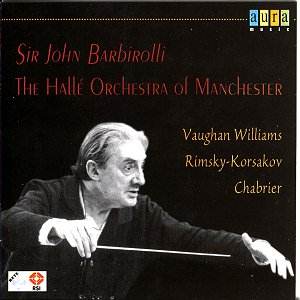Auraís fine disc catches the Hallé and Barbirolli
on tour in Lugano in 1961. Itís an eclectic concert with Barbirolliís
own Elizabethan Suite and some Spanishry in the form of the Capriccio
Espagnol and Chabrierís España. The main focus of interest however
is the work dedicated to him, Vaughan Williamsí Eighth Symphony.
Firstly the Elizabethan confection, which like his
Purcell Suite is anachronistic (even then) charming and irresistible
in equal measure. Byrd, Farnaby and Bull are the composers whose works
are woven into the Barbirollian tapestry. His efforts were certainly
not as pervasive or as famous as those of his occasionally antagonistic
fellow countryman, Thomas Beecham and his Handelian conflations. But
they are cut from recognisably the same cloth even if Barbirolliís are
less pompous and more obviously pliant. They also remind us of Barbirolliís
place in the scheme of things in the renaissance of sixteenth and seventeenth
century music on record - not least when he was part of André
Mangeotís Quartet in the mid-1920s and recording English chamber music
of this period for Compton Mackenzieís National Gramophonic Society
label (an offshoot of the then newly established The Gramophone
magazine). So in this spirit I was immediately seduced by the string
saturation of the Earl of Salisburyís Pavane and the nobility
and expressive diminuendos Barbirolli imparts. As I was by his vigorous
foot stamps in the Irish ho Hoane Ė lashings of gallantry and
vim here as well. The Kingís Hunt ends the suite Ė hurrying,
scurrying strings and a hilarious muted strings episode that should
raise a smile from even the flintiest of hearts.
Rimsky-Korsakovís Capriccio Espagnol opens with glittering
panache but there is also a lilting gravity in the strings that adds
lustre and depth to the performance. The pizzicati are executed with
precision and clarity, a decisive and unstoppable head of rhythmic steam
thus generated and, dynamically vertiginous, the performance ends in
blazing splendour. España is a six-minute encore of animation
and colour in Barbirolliís hands. The Eighth Symphony was in the Halléís
bloodstream by now and they sound marvellously dramatic here. The vibraharp
emerges with clarity; the cellos sound energised and the violins enter
the Fantasy first movement with passionate sweep. Maybe there are some
ensemble slips here but they pale into insignificance when weighed against
the fervour and animation of the playing and the conducting. The melting
second subject, the hushed intensity generated with what one best call
an intense chastity of sound, are all hallmarks of the Barbirolli string
sound and treasurable examples at that. But Barbirolli marshals the
movement to a close with intense concentration, alive to the complex
evolutionary patterns and mutability of the workís direction. In the
Scherzo alla marcia Barbirolli is adept, as few of his competitors ever
are, at the insouciant humour of the movement. The brass-packed punch,
the off-beat stresses, the idiomatic orchestration; this is every bit
as distinctive and complete a sound world as cultivated by,
say, JanŠček in his own very different brass writing. In the beautiful
Cavatina the weight of string tone and levels of emotive intensity are
wonderful to hear, the rise and falling of the lines accommodated with
perfect touch and timing. Whereas in the Toccata finale Barbirolliís
drive and drama, the swirl and the glitter, the resurgent stentorian
brass are all magnificently aflame. Wonderful stuff.
Barbirolliís commercial Eighth is available on Dutton
in their Barbirolli series CDSJB
1021 coupled with the London. A BBC Legends BBCL
4100-2 has the 1967 Prom performance of the Eighth coupled with
Crown Imperial, the orchestration of Baxís Oboe Quintet, Deliusí Cuckoo
and an acetate of Ferrierís Land and Hope and Glory. But this 1961 Lugano
concert is a most dramatic and persuasively alive performance and the
rest of the concert is brimful with incident and colour and life. No
reservations Ė just acclamation.
Jonathan Woolf
